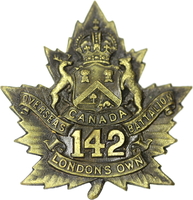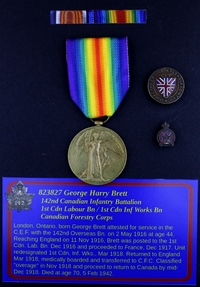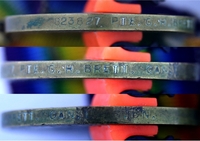
823827 Private George Henry Brett
142nd Overseas Battalion, "London's Own"
1st Canadian Labour Battalion
1st Canadian Infantry Works Battalion
By: Capt (ret'd) Michael M. O'Leary, CD, The RCR
George Harry Brett was in London Township, Ontario, on 24 Dec 1871. Brett and his family can be found in the 1901 Canadian Census. G. Harry Brett (30) and his wife L. Minnie (24) are shown in 1901 with two children; I. George (4) and V. Sara (1). By the time of the 1911 census, two more daughters have joined the family, Irene B. (8 in 1911) and Frances L. (6).
Brett attested for service in the Canadian Expeditionary Force (C.E.F.) with the 142nd Overseas Battalion at London, Ont., on 2 May 1916. A 44-year-old confectioner, Brett was described on his attestation paper as 5 feet 11 inches tall, weighing 168 pounds, with a 39-inch chest, a fresh complexion, grey eyes, and dark brown hair. His religious denomination was Church of England. Brett identified his wife, Minnie Louise Brett, 476 St. James St., London, Ont., as his next of kin. On attesting with the 142nd Battalion, Brett was given the regimental number 823827. In completing his attestation form, Brett declared prior service of 18 years with the 7th Regiment, Fusiliers.
The 142nd (London's Own) Battalion, CEF was based in London, Ont., where the unit began recruiting in late 1915. After sailing to England in November 1916, the battalion was absorbed into the 23rd Reserve Battalion, CEF on 11 Nov 1916.
Brett completed a Particulars of Family form on 18 Oct 1916. On this form he identified his wife's full name, Minnie Louise Brett, and those of five children: George Isadore (18 yrs 8 mos), William Henry (15), Violet Sarah (17), Irene Beatrice (13), and Louise Ellen (11).
Commencing November, 1916, Brett established a monthly Pay Assignment of $20 to be sent to his wife. As a Private in the C.E.F., Brett was paid $1.00 per day play an additional ten cents daily field allowance. His pay assignment represented about two-thirds of his monthly pay. Minnie Brett also received $20 monthly Separation Allowance, which had begun in June, 1916. The amount of separation allowance would increase to $25 per month in December, 1917, and to $30 in September, 1918.
Brett, with the 142nd Bn., embarked at Halifax aboard the S.S. Southland on 1 Nov 1916 for the trip to England. Disembarking in England on 11 Nov 1916, the battalion was immediately broken up and Brett was taken on the strength of the 23rd Battalion at Dibgate the following day.
After a month at Dibgate, Brett was struck off the strength of the 23rd Bn. on transfer to the 64th Battalion at Shoreham on 6 Dec 1916. Originally raised in the Maritime Provinces, the 64th Bn. had reached England in April, 1916, and served a a source of reinforcements for the Canadian Corps until July, 1917.
On 21 Dec 1916, Harry Brett was struck off the strength the 64th Bn. on posting to the 1st Canadian Labour Battalion. The 1st Canadian Labour Battalion was organized at Shoreham in December 1916 and arrived in France 11 Jan 1917. The unit worked on broad gauge railways, roads, light railways, water services, trench cables and salvage. (In September, 1918, the 1st Cdn. Inf. Works Bn, formed the 1st and 3rd Cdn. Inf. Works Companies.)
Brett proceeded overseas on 8 Jan 1917 and disembarked at Havre on 11 Jan 1917. After a year with the Labour Battalion, Brett was granted 14 days leave to the U.K. He proceed on leave on 28 Jan 1918 and returned to the unit on 14 Feb 1918.
On 11 Mar 1918 the 1st Canadian Labour Battalion was redesignated the 1st Canadian Infantry Works Battalion.
Brett was struck off the strength of the 1st Canadian Infantry Works Battalion on 26 Mar 1918 when he was transferred to the Canadian General Depot at Shornecliffe as "exp. Farmer." (If this was to mean "experienced farmer," it is an unusual change of trade for a confectioner.)
Examined by a Medical Board at Somerset Barracks, Shorncliffe, on 11 Apr, 1918, Brett was found to have flat feet. The Board's report described his present condition as:
"Was in France 15 months. Evacuated on account of age stated — 48 years. Radials soft. Heart and chest clear. Both feet are quite flat, inner borders bulging, scaphoids prominent and very little power of inversion standing on toes, etc., but can walk ordinary distances without trouble and is equal to the work in category Bii. No other apparent disability." Medical category Bii was assigned to men who were fit for employment in labour, forestry, and railway units.
A week after being categorized Bii, Brett was taken on the strength of the Base Depot, Canadian Forestry Corps, at Sunningdale from the General Depot on 18 Apr 1918. By the end of that month, on 30 Apr 1918, he was admitted to Beech Hill Hospital, Englefield Green, with bronchitis. After nearly a month in hospital, he was discharged on 27 May 1918. While he was in hospital authority was granted on 2 May 1918 for Brett to wear one Good Conduct Badge.
On 31 May 1918, Brett was detached for duty from the Base Depot of the C.F.C. for duty with the Egham Police. District No. 53 of the C.F.C. was at Ergham, Surrey, and attachments to the local police probably assisted with off-duty soldiers that came under police authority. Brett remained attached until 8 Jul 1918. two days later he was struck off the strength of the Depot and posted to No. 125 Company, District 53, C.F.C.
The Canadian Forestry Corps was authorized in October 1916 and composed of companies grouped under six district headquarters in Great Britain or one of the eight district headquarters in France. The base depot was at Smith's Lawn, Windsor Great Park. Districts in the U.K. were Nos. 51 (Inverness), 52 (Carlisle), 53 (Egham), 54 (Southampton), 55 (Stirling) and 56 (East Sheen). Most companies were engaged in forestry operations (including the making of pitprops, sleepers, sawlogs and axe handles) but some cleared, drained, leveled and graded sites for aerodromes, both in England and in France.
After two months with District 53, Brett was posted to District 54 on 6 Sep 1918. He was taken on the strength of Company No. 125 at Southampton. Organized at Sunningdale in August 1917, No. 125 Company, C.F.C. was employed at Woburn Sands, Beds. from August 1917 to September 1918, at Brokenhurst, Hampshire from August 1918, and at Tisbury from September 1918.
On 20 Nov 1918, Brett was examined by a Medical Board at Dibgate. The Board report stated that Brett's disability was "Overage" and noted that he looked his age. He was recommended for Permanent Base Duty. The same day, Brett was struck off the strength of Dist. 54 and returned to the Base Depot C.F.C.
Brett's journey homeward soon began. On 29 Nov 1918, he was sent On Command, i.e., a temporary duty assignment without changing parent units, to the Canadian Discharge Depot (C.D.D.) at Buxton. A week later, on 5 Dec 1918, he ceased being on command and struck off strength of the C.F.C. when he embarked for Canada on 5 Dec 1918.
Sailing from Liverpool for his return voyage to Canada aboard to S.S. Minnedosa, a Canadian Pacific liner employed as a troopship, Brett disembarked at St John, New Brunswick, on 14 Dec 1918. As he sailed from English shores, Brett was taken on the strength of No. 1 District Depot, London, Ont., effective 5 Dec 1918.
On arriving in London at the District Depot, Brett was posted to the Casualty Company on 16 Dec 1918. He was sent home on furlough from 16 Dec 1918 until 2 Jan 1918, receiving 80 cents per day subsistence allowance in lieu of rations while he was still under military authority.
Back off furlough, Brett was medically examined on 3 Jan 1919 at London, Ont., prior to his discharge. The report of this examination noted distinctive marks, including "small angular scar on upper surface left foot, due to injury in March 1917, at Vimy Ridge." His present condition was summarized as: "Pneumonia in England. In hospital 1 month. No disability now. Pain in left sciatic nerve. No disability now. Both feet flat. Can walk ordinary distances without difficulty. Has difficulty in reading. Being fitted with suitable glasses. No disability due to service."
Harry Brett was discharged from the C.E.F. on 6 Jan 1919 at District Depot No. 1 in London, Ont. His Last Pay Certificate shows his pay and field allowance for the first six days of the month and he received $35 Clothing Allowance and $14.40 subsistence allowance. On discharge, Brett was eligible to receive a War Service Gratuity of $300. Minnie also received a spousal amount of $160. Cheques were issued to both of them in three installments between March and May 1919.
For his service in the C.E.F., Brett was entitled to receive the British War Medal, and the Victory Medal. These were despatched to him at 476 St. James St., London, Ont., on 6 Nov 1923.
Harry Brett died at London, Ont., on 5 Feb 1942 at age 70. He is buried in Woodland Cemetery. Minnie Brett survived her husband by a year, and is buried beside him.
Pro Patria
Visit a randomly selected page in The O'Leary Collection (or reload for another choice):
- The O'Leary Collection; Medals of The Royal Canadian Regiment.
- Researching Canadian Soldiers of the First World War
- Researching The Royal Canadian Regiment
- The RCR in the First World War
- Badges of The RCR
- The Senior Subaltern
- The Minute Book (blog)
- Rogue Papers
- Tactical Primers
- The Regimental Library
- Battle Honours
- Perpetuation of the CEF
- A Miscellany
- Quotes
- The Frontenac Times
- Site Map
QUICK LINKS
The O'Leary Collection—Medals of The Royal Canadian Regiment
Newest additions:
![]()
![]() SB-12725 Private Henry "Hank" Ard
SB-12725 Private Henry "Hank" Ard ![]()
WIA at Hill 187, Died of Wounds in Japan
![]()
![]() 2355331 Lance Corporal Albert Lorking
2355331 Lance Corporal Albert Lorking
Wounded in action, later a War Amps representative.
![]()
![]() 4334 / 477996 Pte Isaac Hamilton Wilcox
4334 / 477996 Pte Isaac Hamilton Wilcox
Permanent Force, South Africa, and C.E.F.
![]()
![]() 477019 Private Harold Ashcroft
477019 Private Harold Ashcroft
Transferred to the Tunnelers.
![]()
![]() 734231 Private Clark D. Thompson
734231 Private Clark D. Thompson ![]()
The older Thompson brother, killed in action.
![]()
![]() 733849 Private Norman Parker Thompson
733849 Private Norman Parker Thompson
The younger Thompson brother; post-war service in the Special Guard.
![]()
![]()
![]() A305 / 400305 Private Andrew Walker
A305 / 400305 Private Andrew Walker ![]()
"Previously reported Wounded, now Killed in Action."
![]()
![]() 823298 Pte Thomas Patrick Steele, M.M.
823298 Pte Thomas Patrick Steele, M.M. ![]()
… for gallant conduct in the field …
![]()
![]() P13066 Sergeant Harold Thompson
P13066 Sergeant Harold Thompson
Instrumental Soloist for over 20 years of Canadian Army service.
![]()
![]() 9609 / 477728 Private Albert Edward Piper
9609 / 477728 Private Albert Edward Piper
"Arrived from England as a STOWAWAY …"




